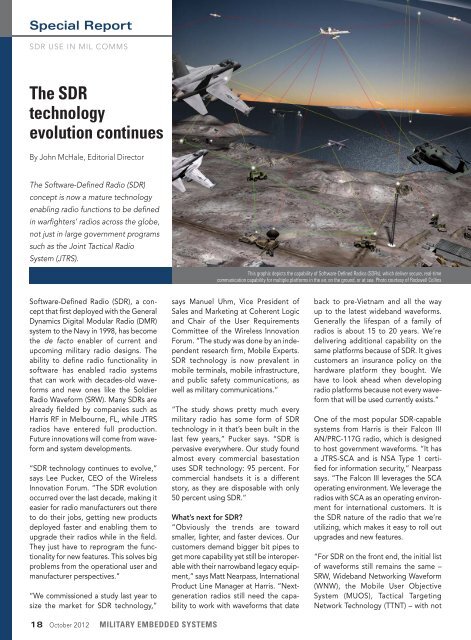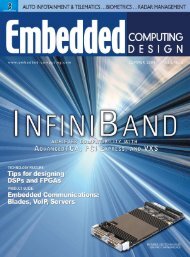Software-Defined Radio technology and market outlook
Software-Defined Radio technology and market outlook
Software-Defined Radio technology and market outlook
You also want an ePaper? Increase the reach of your titles
YUMPU automatically turns print PDFs into web optimized ePapers that Google loves.
Special Report<br />
SDR USE IN MIL COMMS<br />
The SDR<br />
<strong>technology</strong><br />
evolution continues<br />
By John McHale, Editorial Director<br />
The <strong>Software</strong>-<strong>Defined</strong> <strong>Radio</strong> (SDR)<br />
concept is now a mature <strong>technology</strong><br />
enabling radio functions to be defined<br />
in warfighters’ radios across the globe,<br />
not just in large government programs<br />
such as the Joint Tactical <strong>Radio</strong><br />
System (JTRS).<br />
This graphic depicts the capability of <strong>Software</strong>-<strong>Defined</strong> <strong>Radio</strong>s (SDRs), which deliver secure, real-time<br />
communication capability for multiple platforms in the air, on the ground, or at sea. Photo courtesy of Rockwell Collins<br />
<strong>Software</strong>-<strong>Defined</strong> <strong>Radio</strong> (SDR), a concept<br />
that first deployed with the General<br />
Dynamics Digital Modular <strong>Radio</strong> (DMR)<br />
system to the Navy in 1998, has become<br />
the de facto enabler of current <strong>and</strong><br />
upcoming military radio designs. The<br />
ability to define radio functionality in<br />
software has enabled radio systems<br />
that can work with decades-old waveforms<br />
<strong>and</strong> new ones like the Soldier<br />
<strong>Radio</strong> Waveform (SRW). Many SDRs are<br />
already fielded by companies such as<br />
Harris RF in Melbourne, FL, while JTRS<br />
radios have entered full production.<br />
Future innovations will come from waveform<br />
<strong>and</strong> system developments.<br />
“SDR <strong>technology</strong> continues to evolve,”<br />
says Lee Pucker, CEO of the Wireless<br />
Innovation Forum. “The SDR evolution<br />
occurred over the last decade, making it<br />
easier for radio manufacturers out there<br />
to do their jobs, getting new products<br />
deployed faster <strong>and</strong> enabling them to<br />
upgrade their radios while in the field.<br />
They just have to reprogram the functionality<br />
for new features. This solves big<br />
problems from the operational user <strong>and</strong><br />
manufacturer perspectives.”<br />
“We commissioned a study last year to<br />
size the <strong>market</strong> for SDR <strong>technology</strong>,”<br />
says Manuel Uhm, Vice President of<br />
Sales <strong>and</strong> Marketing at Coherent Logic<br />
<strong>and</strong> Chair of the User Requirements<br />
Committee of the Wireless Innovation<br />
Forum. “The study was done by an independent<br />
research firm, Mobile Experts.<br />
SDR <strong>technology</strong> is now prevalent in<br />
mobile terminals, mobile infrastructure,<br />
<strong>and</strong> public safety communications, as<br />
well as military communications.“<br />
“The study shows pretty much every<br />
military radio has some form of SDR<br />
<strong>technology</strong> in it that’s been built in the<br />
last few years,” Pucker says. “SDR is<br />
pervasive everywhere. Our study found<br />
almost every commercial basestation<br />
uses SDR <strong>technology</strong>: 95 percent. For<br />
commercial h<strong>and</strong>sets it is a different<br />
story, as they are disposable with only<br />
50 percent using SDR.”<br />
What’s next for SDR<br />
“Obviously the trends are toward<br />
smaller, lighter, <strong>and</strong> faster devices. Our<br />
customers dem<strong>and</strong> bigger bit pipes to<br />
get more capability yet still be interoperable<br />
with their narrowb<strong>and</strong> legacy equipment,”<br />
says Matt Nearpass, International<br />
Product Line Manager at Harris. “Nextgeneration<br />
radios still need the capability<br />
to work with waveforms that date<br />
back to pre-Vietnam <strong>and</strong> all the way<br />
up to the latest wideb<strong>and</strong> waveforms.<br />
Generally the lifespan of a family of<br />
radios is about 15 to 20 years. We’re<br />
delivering additional capability on the<br />
same platforms because of SDR. It gives<br />
customers an insurance policy on the<br />
hardware platform they bought. We<br />
have to look ahead when developing<br />
radio platforms because not every waveform<br />
that will be used currently exists.”<br />
One of the most popular SDR-capable<br />
systems from Harris is their Falcon III<br />
AN/PRC-117G radio, which is designed<br />
to host government waveforms. “It has<br />
a JTRS-SCA <strong>and</strong> is NSA Type 1 certified<br />
for information security,” Nearpass<br />
says. “The Falcon III leverages the SCA<br />
operating environment. We leverage the<br />
radios with SCA as an operating environment<br />
for international customers. It is<br />
the SDR nature of the radio that we’re<br />
utilizing, which makes it easy to roll out<br />
upgrades <strong>and</strong> new features.<br />
“For SDR on the front end, the initial list<br />
of waveforms still remains the same –<br />
SRW, Wideb<strong>and</strong> Networking Waveform<br />
(WNW), the Mobile User Objective<br />
System (MUOS), Tactical Targeting<br />
Network Technology (TTNT) – with not<br />
18 October 2012 MILITARY EMBEDDED SYSTEMS
















